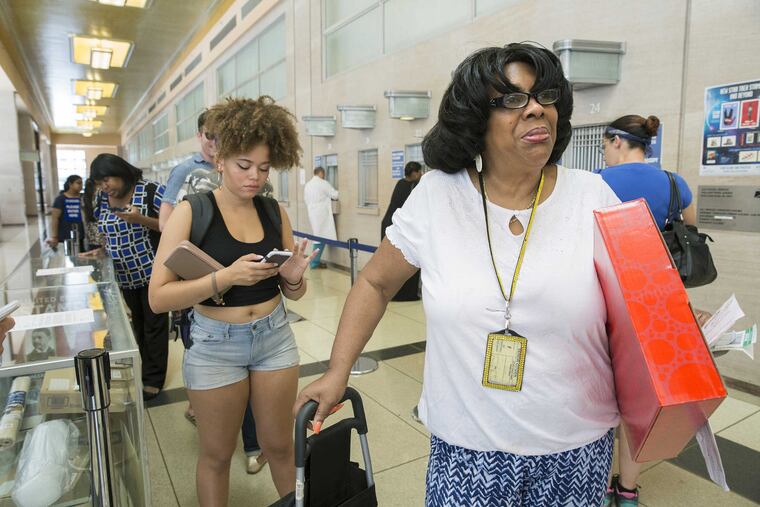Change of address coming for historic Philly post office amid cash crunch

The U.S. Postal Service is downsizing in the city of its birth. Three Philadelphia post offices — including the historic William Penn Annex branch at Ninth and Market Streets — are being moved into smaller nearby spaces to cut costs amid ever-diminishing customer loads.
Some are already lamenting Wednesday's announcement of the loss of the 77-year-old William Penn location, a cavernous space of sleek metal light fixtures and terrazzo floors that is the city's last remaining publicly accessible grand postal hall.
"It's one of our neatest Art Deco interiors that has survived," said Howard Haas, a vocal preservationist in the city. "It will be a shame for everybody when it closes."
The Postal Service's space-reduction campaign — which also will involve relocating its Paschall station at 2904 S. 70th St. in Southwest Philadelphia and its Schuylkill branch at 2900 Grays Ferry Ave. in South Philadelphia — comes as the agency faces increasingly dire financial straits. It has posted an annual loss each year since 2007, shortly after a new requirement began forcing it to set aside $5.5 billion annually for 10 years to cover future medical costs for retirees.
That requirement was imposed just as increased Internet use and the rise of mobile computing battered demand for physical mail by making it easier than ever to send greetings, pay bills, and review documents digitally, said Gene Del Polito, president of the Association for Postal Commerce in Washington.
The total volume of first-class mail, long the Postal Service's biggest money-maker, dropped 36 percent, to 62.4 billion pieces in 2015 from 97.7 billion in 2005, according to the agency's website. Revenue from post office customers fell by a quarter, to $10.4 billion from $13.9 billion, over that time.
"They're in a world of financial hurt," said Del Polito, whose organization represents business users of the Postal Service. Post office visits "are now very few and far between."
The agency's money woes prompted a previous postmaster general to propose shuttering as many as 3,700 offices and eliminating Saturday mail delivery, but such ideas were abandoned in the face of public opposition.
Efforts since then to grant the Postal Service financial relief have included legislation passed in July by the House Committee on Oversight and Government Reform that makes Medicare the primary health insurer for postal retirees, among other measures.
Further balance-sheet improvements are sought by selling underutilized postal properties or moving post offices into smaller, cheaper locations after their leases lapse, said Ray Daiutolo, the Postal Service's spokesman for the Philadelphia metropolitan area.
"We have way too much room," Daiutolo said. "We're looking to right-size some of those scenarios."
Over the last few years, two large Postal Service-owned properties in New Jersey — the Palmer Square post office in Princeton and a disused facility in Lakewood — were sold so operations could be moved into more appropriately sized locations, he said.
In Philadelphia, plans call for moving the Paschall station from the location it has occupied since 1967 into a smaller space in a Postal Service-owned building at 7300 Lindbergh Blvd. The Schuylkill post office, which has occupied its current location since 1997, will move across the street to the Grays Ferry Shopping Center.
But the biggest impact will likely be felt with the relocation of Center City's William Penn Annex branch at Ninth and Market from the six-story Robert Nix Federal Building, which it has occupied since 1939, to a ground-floor space in what's known as the Cast Iron Building at 718 Arch St.
The U.S. General Services Administration, which owns the Nix building, has started considering replacement tenants, focusing on federal agencies within the Philadelphia area, though its review could be extended to include "non-federal entities," GSA spokeswoman Sherrie Taylor said.
The building stands in a still-scruffy but rapidly revitalizing section of Center City — barely a half-mile from the neighborhood where Benjamin Franklin served as the nation's first postmaster general in the 1700s — that is frequented by visitors to the area's discount shopping, government offices, and medical clinics.
On a recent weekday afternoon, a line of about a half-dozen customers stood in the vast postal hall, waiting to be served at one of the branch's two open counters — out of 37.
Joan Luby, 71, who was there to mail a package, said she uses the branch several times a week during her frequent trips to the area from her home in Southwest Philadelphia.
"I just feel comfortable coming here," Luby said. "I'm going to miss it."
The Nix building was constructed in the late 1930s to accommodate courtrooms and federal offices — in addition to the post office — as part of the era's Public Works Administraton aimed at lifting the country out of the Great Depression, according to a 1990 application for inclusion in the National Register of Historic Places.
Other Philadelphia PWA projects include the former 30th Street Station Post Office, the U.S. Custom House, and Central High School, which share the Nix building's Art Moderne architecture.
"They became fortress-like and very much part of the global infrastructure of trade and movement of goods, instead of being civic buildings," Schwarzer said.
When the William Penn Annex opened, the surrounding area of Market East was entering its heyday as a retail mecca, drawing plenty of business to the branch, noted Haas, the preservationist.
Though much of that traffic has since disappeared, the area now seems poised for a resurgence, with major development projects underway all around, which should argue for keeping the branch in place, Haas said.
Among the its newest fans is 22-year-old Temple University student Chloe Brown, who stopped by for the first time recently for a money order.
"This is the nicest post office I've seen in Philadelphia," the Princeton-area native said as she gazed toward the hall's high ceiling. "I'm really shocked how big it is."